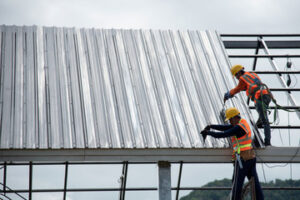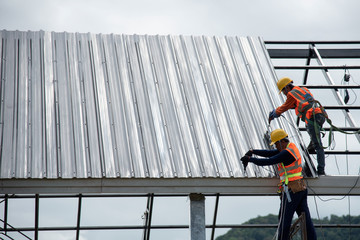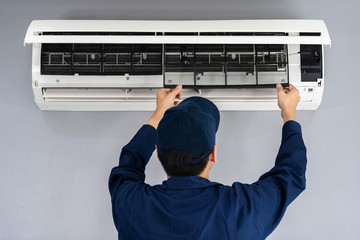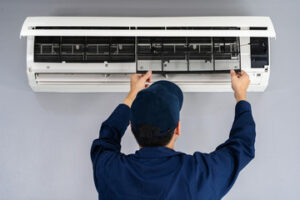Commercial property owners know the value of a strong, well-maintained roof. Prompt repair of minor damage can prevent costly issues that disrupt business operations.
Leaks, sagging roofs and visible wear and tear are a few of the most common commercial roofing problems that warrant attention. Repairing and maintaining these areas of the roof extends its lifespan and protects the valuable inventory and equipment inside the building. Contact Commercial Roof Repair Las Vegas NV for professional help.
In the commercial roofing world, damaged shingles are often an indicator of larger problems. In fact, repairing roof damage is a critical element of routine maintenance and can be used to help identify and prevent serious issues that could require costly replacements or disrupt business operations. Commercial roofs are more prone to damage than residential roofs because they typically house HVAC units, vents, and other mechanical equipment that can create punctures in the roofing material. When these problems are left unchecked, they can lead to water infiltration and structural damage that requires emergency repairs.
During storms, commercial buildings are subjected to high winds and other severe weather conditions that can damage the roof surface. These conditions can also dislodge shingles from the roof surface, leaving them exposed to the elements and creating openings in the protective layer that can allow water and moisture to penetrate the underlying materials. This can cause leaks, wood rot, and other severe problems that can result in extensive repair costs.
It is often easier to replace damaged shingles rather than attempting to repair them. While repairing a shingle with caulk or putty can help, it is often not cost-effective or effective in the long term. Additionally, repairing only the affected shingle can leave the surrounding shingles vulnerable to damage. It is important to have a professional conduct an inspection and make repairs to all damaged areas of the roof.
Commercial roofs are more complex than their residential counterparts, which requires a different set of tools and techniques for repair. In addition, these roofs typically host various mechanical equipment and utility lines that are difficult to access. Despite these challenges, commercial roofs should be inspected regularly to assess the condition of the roof and to identify potential issues before they become serious problems.
One of the most common signs of roof damage is water stains or leaks on the ceiling. These are usually caused by a problem with the roof’s structure, drainage, or the integrity of shingles. Leaks and other problems can lead to a number of costly consequences for the property, including rot or mould, and can significantly impact the resale value of the building.
Leaks
Commercial roof leaks can be one of the most destructive commercial roofing problems. If left unaddressed, they can cause damage to the interior of a building, resulting in water spots on ceilings and walls, as well as mold and mildew, which can threaten the safety and health of the building’s tenants. Leaks are often caused by a combination of factors, including aging of the commercial roof membrane, severe weather, and improper installation and maintenance.
Commercial roofs need to be able to withstand harsh weather conditions. Severe storms can dislodge roofing materials or rip off shingles. Over time, harsh weather can wear down the roof’s membrane and deteriorate insulation. Commercial roofs may also be vulnerable to water leaks from clogged gutters or downspouts, which can create pooling and moisture pockets.
A commercial roof repair expert can address issues with drains, gutters, scuppers and flashing, repairing any gaps or weak points that allow moisture into the commercial property. Commercial roofs can also experience leaks due to surface rips or punctures. These can be the result of debris from severe weather, a fallen tree branch or other object, or even foot traffic on a flat roof.
Another common commercial roof repair concern is a crack in the roof membrane. This can be the result of normal aging, or it could be the result of improper installation, material defects or installation cuts. Cracks in the membrane should be addressed immediately as they are often an indicator of the onset of a serious leak.
Other common commercial roof repair concerns are ponding areas, which may be caused by poor drainage, or by HVAC equipment and pipes that are connected to the commercial roof. Poor drainage can create standing water, which in turn can create a perfect environment for moss and algae to grow.
Commercial roofing repairs may also include replacing damaged shingles, patching holes and re-sealing joints. A professional commercial roofer can evaluate the condition of a commercial roof and determine what is required to restore it to full function, based on the age and severity of the damage. Repairing these issues can extend the life of a commercial roof and prevent costly replacement in the future.
Structural Issues
Commercial roofs protect the integrity and functionality of business operations within a building, so any issues need to be addressed quickly. If left unattended, these problems can become severe enough to compromise the safety and security of occupants and lead to costly structural damage. Proper maintenance and regular inspections help to catch problems early, preventing them from escalating into major concerns.
Whether caused by heavy rain, hurricanes, intense heat, or even simple wear and tear, roof damage can occur due to many factors. Promptly addressing these problems prevents water leaks and other complications.
Some of the most common commercial roof repair problems include leaks, clogged drains, and structural issues. Leaks are one of the most serious commercial roof repairs, as prolonged water exposure can rot wooden structures and cause mold growth, which poses health and safety hazards for occupants.
Leaking is commonly caused by damaged or deteriorated roofing membranes, flashing, or poor installation. If the issue goes undetected, it can result in water damage and costly interior repairs. Insufficient insulation and ventilation can also contribute to leaks, and it is important that these areas are inspected regularly to ensure they are in good condition.
Clogged drains and vents are another common problem, which can result in poor drainage and ponding water. This can weaken roofing materials and increase the risk of structural damage, which is why it is important to keep these areas clear of debris.
A sagging roof deck is a sign of severe problems that need to be addressed immediately. It may be caused by accumulated debris, a collapsed gutter system, or deteriorating or missing shingles. This can cause the structure of the building to weaken, and it should be treated as a critical priority. Documentation is a vital part of the commercial roof repair process, as it allows owners and construction companies to keep track of all the repairs that are being made. It will also allow them to monitor the progress of their renovation projects and ensure all work is done in compliance with applicable codes and regulations.
Re-covering
In many cases, a total roof replacement is not necessary. In some circumstances, a new membrane can be placed atop the existing structure, a technique known as roof re-cover or roof restoration. This approach has a number of advantages over complete tear off, but it’s important to evaluate the current condition carefully before opting for this route.
Commercial roof leaks are a major concern because moisture intrusion compromises the structural integrity of the building, destroys insulation, and promotes mold growth. Promptly addressing leaks prevents damage and saves money.
Storm-Related Damage
Heavy rain, hail, and high winds can cause shingles to crack or rip. This often leads to leaks that can penetrate through the roofing material and into the interior of the facility.
Poor Drainage Systems
Clogged or improperly installed drainage systems allow water to collect on flat and low-slope roofs, which weakens materials and increases the risk of leaks and other structural problems. Regular inspections and repairs to the drainage system help reduce these risks.
Aesthetic Issues
Various types of commercial roofing materials have different resilience levels. Some offer enhanced resistance to high winds, while others are better suited for areas with high temperatures and intense sun exposure. An experienced roofing contractor can help you select the best option for your needs.
Leaky Vents and Chimneys
The flashing around leaking chimneys, vents, and other rooftop equipment is susceptible to corrosion and puncture. A professional roofer can replace the flashing and seal any gaps to stop water infiltration.
Before deciding on the right commercial roof repair solution, gather estimates from several contractors to compare prices and experience. Be sure to consider the warranty offered, whether the company has been in business for a long time, and their certifications and insurance coverage.
It’s also important to choose a commercial roofing contractor that prioritizes safety. Workers should use a harness to support their weight when climbing over the roof and be prepared for the possibility of falling debris. Ensure that ladders are securely attached to the building and are used in accordance with OSHA regulations. A hard hat and eye protection goggles are essential for protecting workers’ heads and eyes from flying debris.


